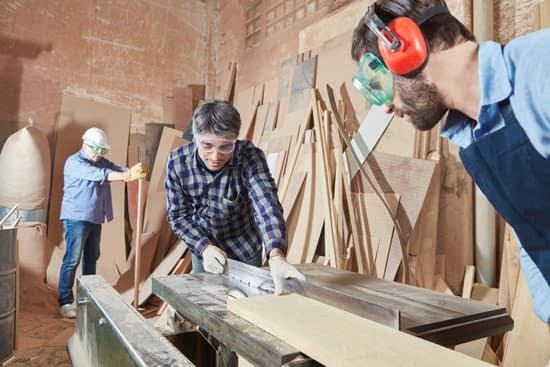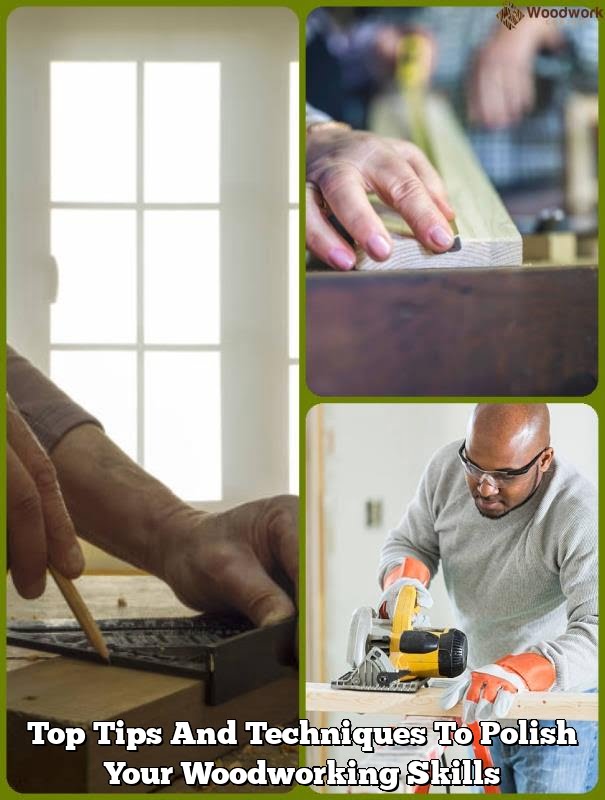
When it comes to woodworking techniques and skills, woodworkers must first develop a basic set of tools, materials, and concepts that are essential for successful projects. It’s important to start small and work your way up with more complex projects, like designing furniture. With practice and patience, you can learn new woodworking techniques and skills easily.
The Basics of Woodworking – Getting Started Before attempting a project with more difficult techniques or tools, it’s best to become familiar with the basics. Woodworkers should know the anatomy of each type of wood they use for a project, as well as the basic joinery techniques used in carpentry.Getting to know how different woods react to different stains and finishes is essential knowledge prior to starting any project.
Additionally, it’s beneficial to understand the safety procedures necessary when operating power tools like routers and Sanders.
Advanced Carpentry Techniques – Proceed with Caution Fine furniture making requires advanced carpentry techniques such as dovetail joints or raised panels. In some instances these elements require a bit more finesse and finesse takes time plus careful attention to detail. Make sure you read through all plans before starting on a project that has complicated techniques involved.
It might be wise to make practice joints before committing them permanently into a piece of furniture or cabinetrywork item. This will help build confidence in those skills before they’re put into long-term use on workspecific projects such as bookcases or kitchen cabinets.
Last but not least always ensure you have quality sharp cutting blades and bits – these will make work much easier but also safer in knowing there are no binding issues coming in play either during process or after completion stages in builds.
Understanding Wood Grain, Knots, Color Variance, and Other Basics
One of the most important woodworking techniques and skills is understanding the nature of wood. Some major aspects of wood to understand are its grain, knots, color variance, and other basics. By learning these elements, one can accurately identify species of wood, select suitable boards for a project, utilize common tools in new ways, and make better finishing decisions.
Wood Grain
Firstly, it is essential to recognize different types and patterns of wood grain. Wood grain can run parallel or cross-grain; straight or irregular; open or closed. Knowing how to read the grain helps ensure that pieces will be cut correctly and fit together properly without splitting along the grain.
Knots
Secondly, knots also need to be taken into consideration when working with wood. It is important to keep in mind that knots can often occur inside a board as well as on its surface.
Large solid knots may weaken the board’s structure while rot pockets, loose knots and splits can create unseen weaknesses in which cracks may emerge later on after machining finishes curing processes are completed. Knowing how to locate knots mid project allows for better planning when making projects such as cabinets where locating sound areas are key to their structural integrity.
Color Variance
Lastly, color variance should be addressed before beginning any project that involves multiple pieces of wood like furniture making or picture frames. By carefully selecting boards with similar grain patterning and coloring from batch to batch ensures that once varnished they will look very uniform from piece to piece without abrupt color shifts occurring during sanding stages that might require objective adjustments with fillers and dyes once assembly has begun.
Best Practices List:
- Be familiar with reading both hardwood and softwood grain.
The Essentials
Woodworking is a skill that involves using special tools and techniques to shape and craft wood into useful products. To be successful, you must have the right tools and knowledge of how to use them correctly. Below are a few essential pieces of equipment that all woodworkers should possess:
- A good saw – A good saw is the most crucial item in any toolbox, as it’s used for cutting through wood with minimal effort.
- Measuring tools – Without accurate measurements your project won’t turn out the way you hoped. Rulers, tape measures, and yard sticks provide a foundation for reliable measurements.
- Sharpening stones – Sharp tools are key to producing good results when woodworking. A sharpening stone can help keep blades sharp and ready for use.
- Chisels – Chisels come in many sizes and shapes making them perfect for carving out interesting shapes or intricate details in wood projects.
- Clamps – Clamps help secure materials while you work. They are invaluable when cutting delicate material or if materials need extra support while being glued together.
In addition to having the necessary equipment for successful woodworking projects, there are certain skills needed to properly use the tools. It is important to understand safety protocols before starting any project, as well as having an understanding of different sawing techniques like cross cutting or rip cuts.
Other skills that become more useful over time include the ability to read plans or assemblies accurately from drawings, being able to select proper joinery applications for each project, filing chamfers on cut edges or curves with ease, developing accurate measurements with hand planes or router bits, and creating custom templates using either jigs or pre-made patterns.
Developing these skills takes practice but they can greatly increase one’s capacity as a proficient craftsman. The ability to hold chisels at varying angles without damaging the blade is also an expert skill original made by master craftsmen with years of experience under their belt; luckily today there are holders available which angle your wrist so that mistakes made by beginners are less likely occur.
Getting Familiar with Power Tools
Power tools are essential for woodworking, allowing us to complete jobs faster and with greater precision. Before they can take full advantage of the benefits of working with power tools, it’s important for woodworkers to first make sure that they understand the various safety protocols associated with their use. Here, we’ll explore in detail how to work safely when using power tools in woodworking projects.
Safety Gear
The most effective way of preventing injury when working with power tools is by ensuring that the right protective gear is worn. This includes:
- Eye protection (goggles or safety glasses)
- Hearing protection (earmuffs or earplugs)
- Foot protection (heavy-duty boots)
- Head protection (hard hats)
In addition, many items of clothing/materials made out of natural fibers can become combustible when exposed to intense friction generated by some power tools, so it’s important to wear fire-resistant materials whenever possible.
Setting Up
It’s also important to establish a well-lit workspace before getting started on any project. This not only reduces the likelihood of accidents due to inadequate light levels but also makes it easier for you to see what you’re doing during more intricate tasks.
Setting up a dust collection system such as a vacuum for sawdust cleanup is equally important as doing so helps protect you from hazardous substances and maintain environmental hygiene levels when sanding or cutting materials.
Furthermore, power tools should be adjusted according to the type of material that needs processing – different blades rotate at varying speeds and require adjustment after changing them – failure to do so could result in extreme levels of damage or destruction being inflicted on the tool itself as well as your workpiece. This includes performing a visual inspection of consumables such as blades and drill bits every few months while making sure no loosened parts remain after use.
How to Choose Wood for Your Projects
Woodworking requires an understanding of the properties and characteristics of various types of woods. Hardwoods and softwoods both offer distinct advantages for certain projects, depending on the desired look, feel, and functionality. It is critical to make sure that you select the right type of wood for each task.
When considering hardwood versus softwood options, it is important to understand the differences between the two. Hardwoods typically come from deciduous trees such as oak or maple and tend to be denser than softwoods.
This means that they are stronger and more durable, making them ideal for furniture or cabinets that will endure a lot of wear and tear or last longer than other pieces made with softwood materials. They also often show different patterns in grain when stained or painted so they can provide more interesting designs when incorporated into a project.
Softwood usually comes from conifers such as pine or cedar and can range from light yellowish-white to deep red or brown tones depending on the species. While softer than hardwood, these materials are still strong enough for certain items like shelving units or outdoor structures that may not need as much weight-bearing capacity as furniture does.
Softwood tends to be less expensive than hardwood so it can be a good choice for larger projects where budget plays a major role in the decision making process.
The following list highlights some important considerations when choosing wood for your project:
- Determine what type of item(s) you’re making – furniture, decoration pieces etc.
- Evaluate its intended purpose – whether something needs to be sturdy/durable or lighter/easier to move
- Consider cost – price differences between hardwoods and softwoods
- Compare how each wood looks when finished (natural/painted)
- Decide which kinds of woods work with your skill level (manufactured woods may require less experience)
Building Basics
One of the most important woodworking techniques for beginners and experienced carpenters alike is to learn the basics of measuring, cutting, and joining materials. Taking accurate measurements and ensuring precise cuts helps ensure that parts will fit together properly. When beginning a project, it’s best to have a plan in mind before starting any woodwork.
Measuring is one of the first steps in any woodworking project. It’s important to take accurate measurements to ensure that any parts you create with saws or other tools are all cut properly and will work together for the end result. Preparing a sketch beforehand can help check accuracy when taking measurements and ensure that no mistakes occur when cutting pieces from larger sizes of material.
Cutting
When it comes to making cuts, there are various tools available depending on the shape of cut required. The jigsaw is an essential tool for making curved cuts in logs or blocks of wood whereas hand saws such as panel saws or Japanese-style saws are used for making straight cuts on flat surfaces.
A miter saw, which is similar to a circular saw but has adjustable angles, can be used for making angled or compound-angled cuts. An electric or hand router can also be used to make grooves in edges or faces of boards and come in edge-guiding designs so operators don’t have to worry about following set patterns while cutting curves into boards.
Joining Techniques
Once multiple pieces are correctly sized and cut, they must be secured together through jointing techniques such as mortise-and-tenon or dowel joints.
Mortise-and-tenon joints use a pins (the tenons) inserted into one board and corresponding slots (the mortises) carved out from another board which interlock when joined; these require precision with specialised equipment such as chisels and mallets for making the highly secure piece that needs little additional reinforcement once pieces are assembled after glueing them together.
Dowel joints can also be used although fewer precision and strength when compared with their mortise-and-tenon counterparts; they involve drilling holes into two boards at 90° degrees from each other then inserting cylindrical pegs into respective holes before clamping them down with adhesives.
Professional Joining Techniques
Joining techniques are an important part of any carpentry or woodworking project. With the right joining techniques, not only can you create strong projects that will last for years to come but you can also add a professional-looking finish to the pieces.
Framing and mitering both involve joining two materials together in an aesthetically pleasing way. Framing involves securing four pieces of material together using glue or fasteners, while mitering requires cutting angles into each of the two pieces so that when put together, they fit neatly around a corner.
When it comes to framing, one popular option is rabbet joints which involve cut out sections at the end of each piece allowing them to fit snugly and securely against one another. A wooden joint clamp can be particularly useful when securing rubber joints as it applies pressure evenly across the entire width of the join eliminating gaps and voids which could let water or air pass through.
Another useful tool for creating perfect mitering joints is a miter saw which uses spinning blades to accurately form angled cuts at 90 degrees as well as other angles allowing you achieve consistent results and tight corners. You must treat rare woods with care when miter cutting as they are more prone to splitting if too much force is applied during cutting.
Professional carpenters will use specialized equipment such as belts sanders, jigsaws or even router tables for creating precise miter cuts on hardwoods like oak or walnut for furniture making.
No matter what kind of woodworking project you’re undertaking it is important to understand the different techniques and skills needed in order make high-quality projects that look great and last for generations. By understanding some basic but important concepts such as framing and mitering basics, you’ll have a great foundation for tackling more complex tasks in your future endeavors.
Finishing Techniques
Sanding is one of the most important woodworking techniques and skills as it creates a smooth and even surface. It can also provide an even base for additional treatments and finishes. Sanding can be done manually or with a powered sander, although manual sanding still provides much better results. It is important to take the time to progress gradually through all grit types, using progressively finer ones until the desired smooth result is achieved.
Painting is another common finish for woodworking projects, providing protection from the elements as well as a decorative touch. The key step before painting wood is to ensure any sanding residue is completely removed in order to promote adhesion of the paint onto the surface.
Other treatments such as primers or sealing coats may be applied prior to painting depending on the type of project. Latex or oil based paint are two common options, but there are many other products available that provide similar performance along with more specialized features such as improved weather resistance or extreme durability.
Staining is a third option when it comes to finishing techniques and skills used in woodworking projects. This process will permanently change the colour of the wood’s surface and does not require sealing following application.
Generally speaking this process requires minimal effort and preparation compared with painting as only light sanding may be needed beforehand if desired; however some staining products require more elaborate pre-treatment steps such as pre-stain conditioner which helps improve absorption into the woods grain. In either case, protective clear coats should always be used after staining in order to protect against fading or damage from UV light or water exposure.
Examples of Advanced Woodworking Skills
Carving is one of the most complex and delicate woodworking techniques. Using precise tools and a steady hand, artisans can produce intricate works of art with great precision and attention to detail. Typical carving techniques involve chisel work, gouge work, sawing, cutting, shaping, sanding, smoothing and finishing. With the right tools and experience an artisan can turn a simple block of wood into a beautiful decoration or piece of functional furniture.
Joinery Techniques
Woodworking joints are an important part of any carpentry project. Joining two pieces of wood requires intricate skill as different types of joints permit different amounts of movement in relation to each other. Popular joinery techniques include doweling, dovetailing, biscuit joining and mortise-and-tenon joinery. Each method has its own unique range of strengths ad weaknesses which should be considered before selecting the proper joint for the task at hand.
Creating Intricate Inlays
Inlay is another relatively advanced woodworking technique which utilizes contrasting materials for decorative effect. A typical example might be combining ebony strips with maple surfaces to create decorative borders around table tops or construct geometric patterns within surfaces.
This process relying on extreme accuracy when cutting out channels for the inlay as even minor discrepancies can affect the alignment or secure placement within these grooves. Experienced crafters refine their techniques through careful practice and knowledge gained from trial-and-error efforts ensuring that they have both adequate patience and technical knowhow when faced with more challenging projects down the line.
Final Thoughts
Having the right woodworking techniques and skills for the job can make all of the difference when it comes to creating something beautiful and functional. Equally important, however, is knowing what type of material works best with each technique. A carpenter’s tools are only as good as his woods.
Knowing which methods to use when crafting a piece of furniture or a workbench is essential in order to achieve desired results. Fortunately, there are a number of resources available both online and offline that can provide in-depth guidance on how to effectively incorporate woodworking techniques into projects.
Woodworking techniques range from the simplest cuts and shapes like drilling and planing, to more complex crafting such as turning and dovetailing – each providing a unique way to join two pieces of wood together. Working with wood also requires precision when sanding, shaping, molding, routing, staining, polishing or finishing a project.
Basic tools like saws and chisels are used commonly for cutting through wooden blocks; however, other specialized devices like jigsaws and routers might be needed depending on the task at hand. To get an accurate measure of a piece of wood before cutting or joining it together in any way is important too; accuracy helps prevent mistakes from becoming irreparable errors later down the line during construction processes.
Resource recommendations come in term materials with ideas about types of woods that fit particular projects best – such as using strong hardwoods for heavier constructions like table legs – as well as informational books on woodworking techniques describing step-by-step guides on how to execute specific jobs successfully. Magazines may also offer slight variations between methods employed by different people working within similar spaces.
Online videos from respected makers’ guilds or blogs can supplement this research further too with tips from even veteran craftsmen who have tackled technically difficult scenarios before you embarked on yours Whatever you choose – proper instruction from sources you trust will help ensure your project ultimately yields success.




